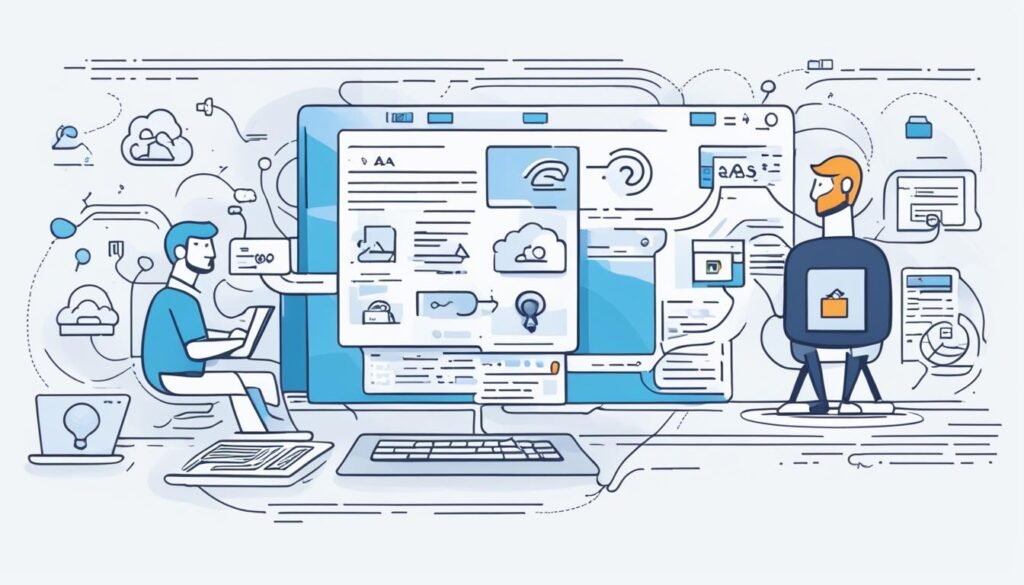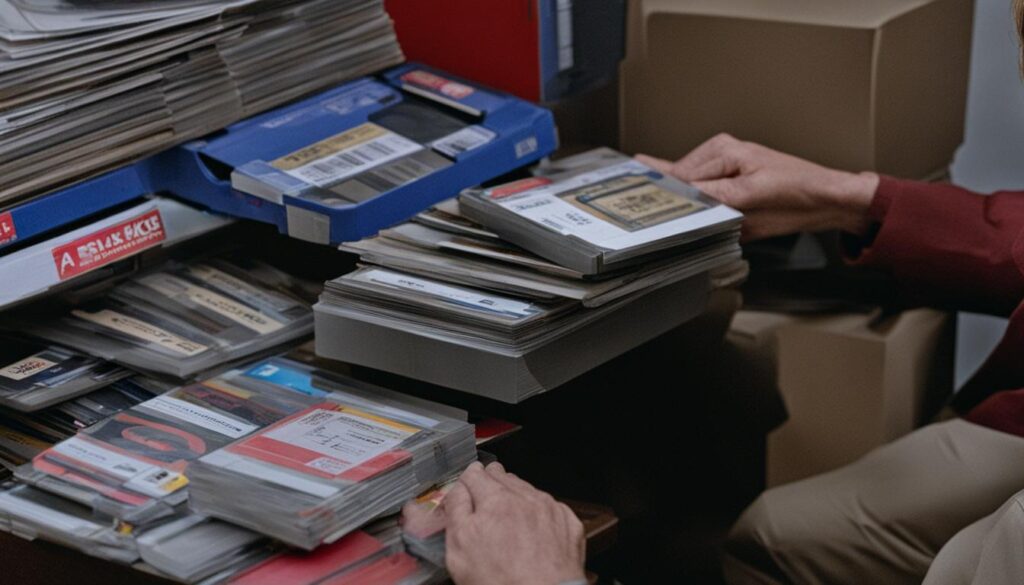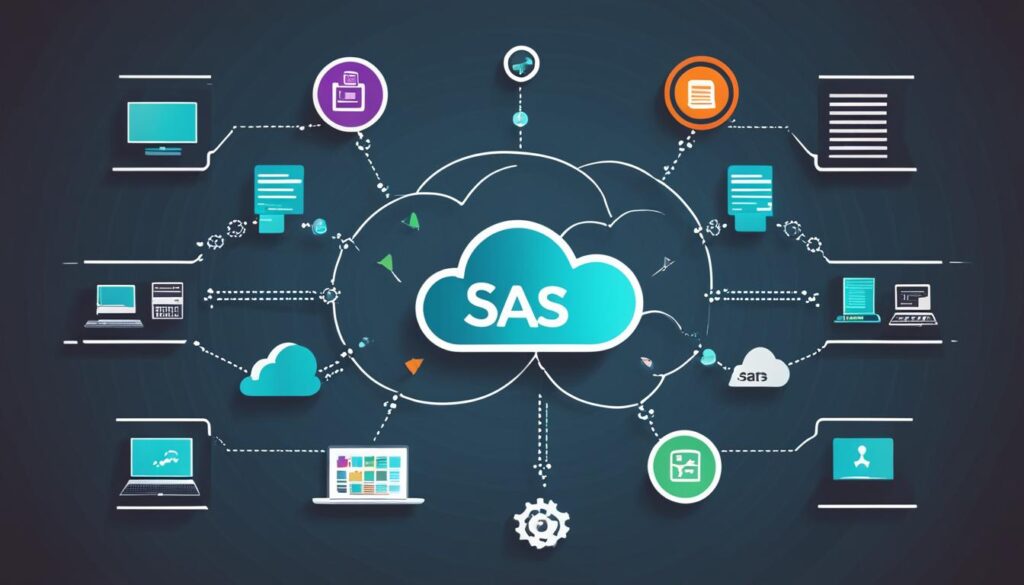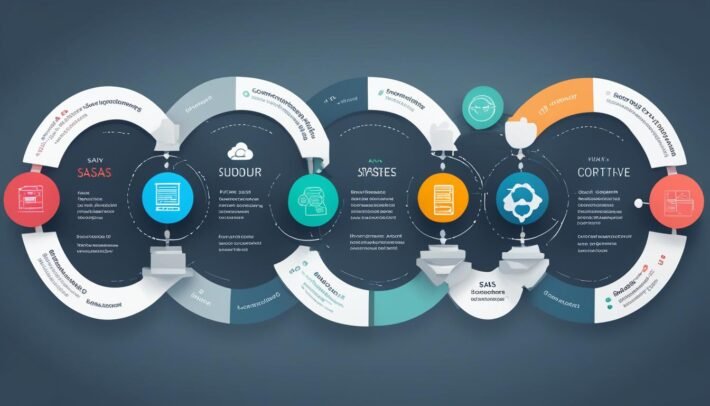SAAS vs. Traditional Software: Advantages and Differences

In today’s ever-evolving tech landscape, businesses face a daunting task when it comes to selecting software solutions that best meet their needs. Among the most important decisions is whether to opt for Software-as-a-Service (SAAS) or traditional software.
SAAS is a cloud-based computing model that allows users to access software applications over the internet, avoiding the need for on-premises installations. Traditional software, on the other hand, is a more conventional approach in which software is downloaded and installed locally on a device.
In this article, we will explore the key differences and advantages between SAAS and traditional software. Understanding these distinctions will help you make an informed decision about which option is best suited for your business needs.
Key Takeaways:
- SAAS and traditional software differ in deployment, maintenance, cost structure, and scalability.
- SAAS offers advantages such as cost-effectiveness, easier updates and maintenance, accessibility, and scalability.
- Traditional software provides advantages such as customization, control, and potentially lower long-term costs.
- Factors such as budget, IT resources, business needs, and security should be considered when choosing between SAAS and traditional software.
- Understanding the financial implications of each option is crucial in making a cost-effective choice.
What is SAAS?
Software-as-a-Service, or SAAS, is a cloud-based software delivery method that enables businesses to access software applications over the internet instead of installing them on local machines. Unlike traditional software, SAAS providers are responsible for the maintenance, upgrades, and security of the software, making it a hassle-free solution for businesses.
One of the biggest advantages of SAAS is its scalability, allowing businesses to easily scale up or down depending on their changing needs. Additionally, pay-as-you-go pricing models mean that businesses only pay for what they use, providing a cost-effective solution.
Compared to traditional software, SAAS offers greater flexibility, availability, and ease of use. With SAAS, businesses can access software and data from anywhere, at any time, as long as an internet connection is available.
Understanding Traditional Software
Before we dive into the comparison between SAAS and traditional software, it’s important to understand the characteristics of traditional software. Traditional software is typically installed on local hardware or servers and runs directly on the computer that it’s installed on.
The installation process for traditional software can be time-consuming, and maintenance and updates are usually handled by in-house IT staff. Security is also controlled in-house, which may require additional resources and expertise. One major advantage of traditional software is that it allows for more customization and control over features and functionality.
It’s worth noting, however, that traditional software may have limitations in terms of scalability and accessibility. Depending on the size of the business and the number of users, traditional software may become cumbersome to maintain and support. Additionally, access to the software is typically limited to devices on which it’s installed, which may restrict remote work capabilities.
In the table below, we summarize the key features of traditional software:

| Feature | Traditional Software |
|---|---|
| Installation | Local hardware or servers |
| Deployment | Manual installation on each device |
| Maintenance and Updates | Managed in-house by IT staff |
| Security | Controlled in-house |
| Customization and Control | More control over features and functionality |
| Scalability | Limited scalability for larger businesses |
| Accessibility | Access limited to devices on which software is installed |
Keep these features in mind when comparing traditional software to SAAS in the next section.
Key Differences between SAAS and Traditional Software
When evaluating software options for your business, it’s essential to understand the key differences between SAAS and traditional software. Below, we’ll outline some of the most significant differences, including:
Deployment
One of the most significant differences between SAAS and traditional software is how they’re deployed. SAAS is typically hosted in the cloud and accessed over the internet, while traditional software is installed on local hardware or servers. This means that SAAS is typically easier and faster to set up, while traditional software may require additional hardware and IT resources for installation.
Maintenance
Another key difference is the level of maintenance required for each option. With SAAS, the vendor is responsible for software updates and maintenance, while with traditional software, these responsibilities fall on the business. This means that SAAS generally requires less time and effort to maintain, but businesses may have less control over updates and customizations.
Cost Structure
The cost structure for SAAS and traditional software also differs significantly. SAAS is typically billed on a subscription basis, with costs varying based on usage and scale. Traditional software, on the other hand, often involves a one-time purchase price, but may require ongoing maintenance and support fees. This means that SAAS may be more cost-effective for businesses with fluctuating needs, while traditional software may be cheaper in the long run for businesses with consistent, predictable usage.
Scalability
Finally, scalability is another key factor to consider. SAAS is known for its scalability, with vendors offering flexible usage plans and the ability to add or remove users as needed. Traditional software, on the other hand, may be less flexible in terms of scaling, often requiring additional hardware and software purchases to accommodate growth.
By understanding these key differences, businesses can make informed decisions about which software solution aligns best with their needs.
Advantages of SAAS
SAAS offers several benefits over traditional software models. Understanding these advantages will help you assess whether SAAS is a suitable choice for your business.
Cost-effectiveness
One of the key advantages of SAAS is its cost-effectiveness. With SAAS, you typically pay a monthly or annual fee, which can be more affordable than the upfront costs of traditional software. Additionally, SAAS providers often handle maintenance and updates, reducing the need for specialized IT staff or expensive software licenses. This can save your business a substantial amount of money over time.
Easier updates and maintenance
SAAS providers typically manage software updates and maintenance, which means you don’t have to worry about maintaining the software yourself. This can save time and effort for your IT department or other staff and reduce downtime for your business.
Accessibility
SAAS software is often accessible from anywhere with an internet connection. This means your employees can work from anywhere, which can increase productivity and flexibility. Additionally, many SAAS providers offer mobile apps, allowing your employees to access the software from their smartphones or tablets.
Scalability
SAAS software is often scalable, meaning it can grow with your business. As your business expands and your needs change, you can upgrade or downgrade your SAAS plan to suit your needs. This can save your business money and provide flexibility as you grow.
Overall, SAAS offers several advantages over traditional software, including cost-effectiveness, easier updates and maintenance, accessibility, and scalability. Understanding these advantages is crucial in determining whether SAAS or traditional software is the best choice for your business.

Advantages of Traditional Software
While SAAS has its unique advantages, traditional software also offers a range of benefits that make it an attractive option for some businesses.
Customization: One of the biggest advantages of traditional software is its customization capabilities. Unlike SAAS, traditional software can be tailored to the individual needs of a business. This level of customization can increase efficiency and performance by providing a tailored software experience.
Control: Traditional software provides businesses with complete control over the software. This allows businesses to manage their data and software without relying on the third-party provider of SAAS. This control can be especially useful for businesses that require enhanced data security.
Potentially lower long-term costs: While SAAS may offer lower upfront costs, traditional software can be more cost-effective in the long-term. This is especially true if businesses have ongoing software needs, as paying for a software license can ultimately be less expensive than paying a monthly subscription fee.
Overall, the advantages offered by traditional software can make it a strong contender for businesses that value customizability, control, and long-term cost-effectiveness.
Factors to Consider When Choosing Between SAAS and Traditional Software
When it comes to choosing between SAAS and traditional software, there are several factors that you should consider to make the right decision for your business needs. Here are some key factors:
Cost
Cost is one of the most significant factors to consider when choosing between SAAS and traditional software. SAAS typically has lower upfront costs and pay-as-you-go pricing models, while traditional software often requires significant upfront investment. It’s important to evaluate your budget and determine which pricing model aligns better with your financial goals.
IT Resources
The resources available within your company’s IT department can play a crucial role in deciding between SAAS and traditional software. SAAS is typically easier to implement and requires less IT support, making it ideal for companies with limited IT resources. In contrast, traditional software often requires more IT resources and maintenance to ensure smooth operations.
Business Needs
The unique needs of your business should be a significant consideration when choosing between SAAS and traditional software. SAAS often provides more accessible, out-of-the-box solutions, while traditional software offers more customization and control over features and functions. Look closely at your business goals and needs to determine which option is best for you.
Security
Security is a crucial factor to consider when selecting software solutions. SAAS offers centralized security and data handling, making it easier to manage security threats. Traditional software may require more attention to security measures and compliance standards to ensure data protection against potential threats.
Comparing SAAS vs. Traditional Software
| Factors | SAAS | Traditional Software |
|---|---|---|
| Cost | Low upfront costs, pay-as-you-go model | Higher upfront investment |
| IT Resources | Requires fewer IT resources and maintenance | May require more IT support for implementation and management |
| Business Needs | Provides accessible, out-of-the-box solutions | Offers more customization and control over features and functions |
| Security | Centralized security and data handling | May require more attention to ensure data protection and compliance standards |
Integration and Compatibility
One critical aspect to consider when comparing SAAS and traditional software is their integration and compatibility with other systems. SAAS offers significant advantages in this regard, as it is designed to be flexible and easily integrated with other software solutions. SAAS providers typically offer robust APIs and make it easier for users to connect their software with other systems, which is especially attractive for businesses that require data sharing across multiple platforms.
On the other hand, traditional software often requires custom integration with other systems, which can be costly and time-consuming. Additionally, traditional software may not be compatible with modern APIs and other technologies that are available in the market today.
Ultimately, the ease of integration and compatibility with other systems is an essential consideration when deciding between SAAS and traditional software, as it can have a significant impact on the overall efficiency and productivity of your business operations.

Security Considerations
When it comes to choosing between SAAS and Traditional Software, security is a crucial factor to consider. Both SAAS and Traditional Software have unique security measures in place to protect your business, but they differ in their approach.
SAAS providers typically have dedicated security teams that can continuously monitor and update the software to address potential vulnerabilities. This means that your data is secured not just with the right measures but also through proactive updates and maintenance. In contrast, Traditional Software generally requires in-house IT teams to manage updates and security in-house, which means that the responsibility falls on your team to ensure that all security protocols are in place.
Another key difference pertains to data handling. SAAS vendors must adhere to data privacy and security regulations, while Traditional Software’s security measures may depend on the efforts of your IT department and adherence to regulations. Be sure to check all regulations pertaining to data handling and make sure your business meets any regulatory obligations and expectations.
Compliance Standards
When selecting between SAAS and Traditional Software, it is important to understand how each option addresses compliance standards. SAAS providers may have a centralized compliance team that stays up-to-date with the latest regulations and ensures that compliance standards are met. Some SAAS providers also offer certifications, such as ISO, HIPAA, or SOC, which can lend additional credibility to the quality of their product.
Traditional Software’s compliance standards may depend on your organization’s ability to stay up-to-date with the latest regulations, which can become an overhead when dealing with complex compliance standards.
Cost Comparison and ROI Analysis
Cost is a crucial factor that businesses consider while choosing between SAAS and traditional software. Both software models come with different cost structures, which can have different implications on the business’s budget and financial performance. Below, we will discuss some key cost factors that can influence the decision-making process.
Upfront Costs
One of the most significant differences between SAAS and traditional software is the upfront costs. Traditional software requires businesses to pay upfront for the software licenses, installation, and customization costs. These costs can be substantial, especially for complex and large-scale software solutions. On the other hand, SAAS providers typically offer pay-as-you-go subscription models, which can significantly reduce upfront costs. The subscription fee includes software access, maintenance, and support, making it easier for businesses to allocate their budget and resources.
Ongoing Expenses
Besides the upfront costs, ongoing expenses are another critical factor to consider while evaluating SAAS and traditional software. Traditional software involves additional expenses, such as hardware costs, IT staff salaries, upgrades, updates, and maintenance costs. These expenses are recurrent and can add up over time, creating financial burden for the business. SAAS, on the other hand, typically includes these costs in the subscription fee, making it more predictable and manageable for businesses.
Return on Investment (ROI)
While comparing the costs of SAAS and traditional software, businesses should also consider their return on investment (ROI). ROI is a measure of how much value a software solution can generate for the business, relative to its costs. SAAS can deliver several benefits that can drive ROI for businesses, such as:
- Lower upfront costs, freeing up resources for other business needs
- Easier and quicker implementation and adoption, reducing operational downtime
- Scalability and flexibility, allowing businesses to adjust their software needs to match their growth and changing requirements
- Automatic updates and maintenance, reducing the burden on IT staff and improving software performance and security
By contrast, the benefits of traditional software are primarily related to customization and control over software features and data. However, these benefits may not translate to higher ROI if the costs and management efforts outweigh the benefits.
Case Studies and Real-World Examples
Real-world examples play a crucial role in understanding how SAAS and traditional software fit into different business models. By examining case studies of companies that have chosen one or the other, it becomes clear that there is no one-size-fits-all solution. Here are a few examples:
Salesforce
Salesforce is a well-known SAAS provider that offers a CRM solution with customizable features. The company is a prime example of the benefits of SAAS, with its cloud-based software being accessible from anywhere with internet access. Salesforce’s platform is also highly scalable, and the company has been able to continuously improve its product by releasing frequent updates and new features. The cost-effectiveness of SAAS has also been a significant factor in Salesforce’s success, with subscription fees being more affordable than traditional software licensing fees.
Adobe
Adobe is a leading provider of creative software, offering an array of products such as Photoshop, Illustrator, and InDesign. Adobe’s traditional software model has successfully catered to professional designers and creative agencies who require more customized functionality. Adobe’s customers own the software outright, which provides them with more control over its customization and use. Adobe has been successful in providing regular updates and tech support for traditional software at a lower cost over time.
Caterpillar Inc.
Caterpillar Inc. is a leading corporation that manufactures a range of industrial equipment. The company’s decision to invest in traditional software solutions was based on their long-term cost benefit analysis and the level of customization and control that traditional software offers as compared to SAAS. The company’s adoption of conventional software has also allowed it to streamline its data handling and internal processes to tailor their workflows to the specific tasks their products are designed for.
These examples showcase that each company needs to evaluate its business needs and the underlying nuances such as cost structure, control, management, long-term costs, data handling, security and customization to make informed decisions when choosing between SAAS and traditional software.
Future Trends and Considerations
As technology continues to evolve, the software industry is constantly changing. In this section, we will explore some of the future trends and considerations that may impact the choice between SAAS and traditional software.
Emerging Technologies
The software industry is constantly being disrupted by emerging technologies such as artificial intelligence (AI), machine learning, and the Internet of Things (IoT). These technologies have immense potential to reshape the software landscape, leading to increased opportunities for SAAS and traditional software providers.
Industry Shifts
The shift towards cloud computing, coupled with the rise of remote work, has fueled the growing popularity of SAAS solutions. As more businesses make the transition to digital operations, we can expect to see a continued rise in the adoption of SAAS software. However, traditional software providers can still thrive by offering unique value propositions such as greater control and customization.
Regulatory Compliance
Regulatory compliance is becoming an increasingly important consideration for businesses looking to choose between SAAS and traditional software. With data privacy laws such as GDPR and CCPA, businesses are under increasing pressure to ensure that their software solutions comply with these regulations. SAAS providers have an advantage in this regard, as they take responsibility for compliance while traditional software users must ensure their own compliance.
Conclusion
Choosing between SAAS and traditional software is a critical decision that can have a significant impact on your business operations and financial outcomes. This article has explored the key differences, advantages, and considerations associated with each option to assist you in making an informed choice.
SAAS offers significant benefits such as cost-effectiveness, ease of maintenance, scalability, and accessibility, while traditional software offers advantages such as customization, control, and potentially lower long-term costs. Ultimately, the choice between SAAS and traditional software depends on your unique business needs, budget, IT resources, and security requirements.
By considering factors such as integration, compatibility, security, and cost comparison, and reviewing real-world case studies, you can make a well-informed decision. As technology continues to evolve, it is important to stay up-to-date on future trends and considerations that may impact the SAAS vs. traditional software decision.
We hope this article has provided valuable insights and guidance for your software selection process. Remember, choosing the right software solution is a crucial step towards achieving your business goals and outcomes.
FAQ
What is the difference between SAAS and traditional software?
SAAS (Software-as-a-Service) is a cloud-based model where software is accessed online, while traditional software is installed and run directly on individual computers or servers. SAAS offers benefits like easier updates, scalability, and lower upfront costs, while traditional software provides more customization options and potentially lower long-term costs.
What are the advantages of SAAS?
SAAS offers several advantages such as cost-effectiveness, easier updates and maintenance, accessibility from anywhere, and scalability to accommodate business growth. It allows businesses to access advanced software solutions without investing in expensive infrastructure or IT resources.
What are the advantages of traditional software?
Traditional software provides greater control and customization options compared to SAAS. It allows businesses to tailor the software to their specific needs and operate without relying on an internet connection. Additionally, in some cases, traditional software may have lower long-term costs for businesses that do not require frequent updates or scalability.
How do I choose between SAAS and traditional software?
When choosing between SAAS and traditional software, consider factors such as your budget, IT resources, business needs, security requirements, and compatibility with existing systems. Assessing these factors will help you determine which option aligns better with your specific requirements.
Is SAAS more secure than traditional software?
Both SAAS and traditional software can offer robust security measures, but the specific security level depends on various factors like data handling practices, compliance standards, and the provider’s infrastructure. It’s essential to evaluate the security features of each option and ensure they align with your business’s security requirements.
What is the cost comparison between SAAS and traditional software?
The cost comparison between SAAS and traditional software depends on factors such as upfront costs, ongoing expenses, and return on investment. While SAAS generally has lower upfront costs and easier scalability, traditional software may have lower long-term costs for businesses that do not require frequent updates or extensive scalability. Conducting a thorough cost analysis will help determine the most cost-effective option for your business.
Can SAAS and traditional software be integrated with existing systems?
Both SAAS and traditional software can usually be integrated with existing systems, but the level of integration may vary. SAAS often offers seamless integration capabilities due to its cloud-based nature, while traditional software may require additional customization and development for integration. It’s important to evaluate the integration capabilities of each option and ensure compatibility with your existing systems.
Are there any case studies or examples of businesses using SAAS or traditional software?
Yes, there are numerous case studies and real-world examples of businesses successfully using either SAAS or traditional software. These examples showcase the experiences, successes, and challenges faced by businesses in their software selection process. Exploring these case studies can provide valuable insights and help you better understand the practical applications of each option.
What are the future trends and considerations for SAAS and traditional software?
The future trends and considerations for SAAS and traditional software include emerging technologies, industry shifts, and potential developments that may influence the choice between the two options. Staying informed about these trends and considering their impact on your business will help you make future-proof software decisions.



